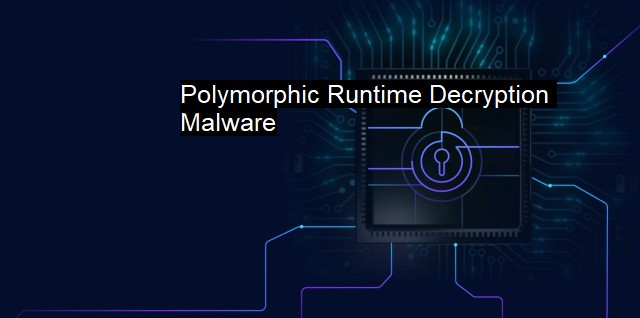What is Polymorphic Runtime Decryption Malware?
Unmasking the Polymorphic Runtime Decryption Malware: A Closer Look at its Evolving Threat Landscape and the Challenges Faced by Security Professionals
Polymorphic Runtime Decryption Malware is an advanced form of malicious software (malware) designed to evade detection by traditional antivirus and cybersecurity systems. It achieves this by constantly altering its own code or encodings, making it incredibly difficult to identify.The underlying concept behind polymorphism in malware is akin to a biological virus mutating to evade the immune system. In software terms, polymorphic malware can produce trillions of potential variants through its mutating techniques, rendering signature-based antivirus detection methods impotent, as these rely on recognisable patterns to identify threats.
To further enhance its elusiveness, such malware often uses a technique called Runtime Packing. During Runtime Packing, parts of the malware code will be encrypted. This encrypted code is then only decrypted at runtime, meaning that the code previous to decryption is not accessible or visible to antivirus procedures.
To enable this decryption process at runtime, the malware package includes a decryption routine or algorithm. This algorithm only becomes active at the time of execution or when a specific condition or trigger event occurs, at which point it decrypts the malware and launches it on the host system. Once the malware has been executed, it again encrypts critical sections of its code to prevent potential investigation, entering a cycle of encryption-decryption-encryption.
This continuous metamorphosis represents a significant challenge to cybersecurity. Common antivirus procedures, including static analysis and behaviour-based detection, relying on identifying specific segments of codes that are malicious are ineffective against polymorphically encrypted malware as its looks different every time it deploys and behaves inconsistently. it can appear innocuous until triggered to execute the encrypted malicious code, making it hard for systems to predict its trigger and proactively prevent malware from propagating.
To counter polymorphic runtime decryption malware, an advanced suite of security measures is necessary. Heuristic-based threat detection is a technique used in many advanced antivirus scanners. By examining a program's behaviour-heavy instructions rather than the overall code structure, heuristic detection can identify unusual or suspicious behaviour indicative of malware.
Machine Learning (ML) and Artificial Intelligence (AI) are also fast emerging as tools to identify and prevent polymorphic malware spread. By analysing vast volumes of historical data, these systems can identify patterns and behaviours not immediately obvious to a human or traditional system. Then, upon detection, they can more accurately predict what the malware will do next and more effectively quarantine it.
InfoSec teams must always update and reinforce their pointer analysis, code normalisation, and wrapper analysis practices. Simultaneously these teams must instate the routine of constant monitoring, behavioral analytics, configuration and patch management, to ensure the highest level of security against polymorphic runtime decryption malware.
When faced with increasingly advanced threats like polymorphic runtime decryption malware, it is clear that constant vigilance and unwavering innovation go hand-in-hand. Cybersecurity professionals must always refine and implement diverse methodologies, analysis mechanisms, state-of-the-art tools equipped with AI and ML, not forgetting survivability models because the war against cyber threats, in its ever-evolving glory, is never over. An effective defense strategy would indeed be layered, targeting multiple attack vectors and updating with the latest advances in cybersecurity strategy to assure security.

Polymorphic Runtime Decryption Malware FAQs
What is polymorphic runtime decryption malware?
Polymorphic runtime decryption malware is a type of malicious software that can change its code and behavior to evade detection by antivirus programs. It uses a decryption routine to unpack its main code, which allows it to change its appearance and make it difficult for antivirus software to identify.How does polymorphic runtime decryption malware work?
Polymorphic runtime decryption malware works by encrypting its main code and using a decryption routine to unpack it at runtime. The decryption routine is often polymorphic, meaning it changes each time the malware is run, making it difficult for antivirus software to detect. Once the main code is unpacked, the malware can execute its malicious activities.What are the risks of polymorphic runtime decryption malware?
Polymorphic runtime decryption malware poses a significant risk to computer systems and networks. It can be used to steal sensitive data, install additional malware, and carry out other malicious activities. Its ability to evade detection by antivirus software means that it can remain undetected for long periods and cause significant damage.How can I protect my computer against polymorphic runtime decryption malware?
To protect your computer against polymorphic runtime decryption malware, it is important to keep your antivirus software up to date and to use additional security measures such as firewalls and intrusion detection systems. It is also important to be cautious when opening email attachments or downloading files from the internet, as these are common vectors for malware infections. Regular backups of important data can also help to mitigate the damage caused by a malware infection.| | A | | | B | | | C | | | D | | | E | | | F | | | G | | | H | | | I | | | J | | | K | | | L | | | M | |
| | N | | | O | | | P | | | Q | | | R | | | S | | | T | | | U | | | V | | | W | | | X | | | Y | | | Z | |
| | 1 | | | 2 | | | 3 | | | 4 | | | 7 | | | 8 | | |||||||